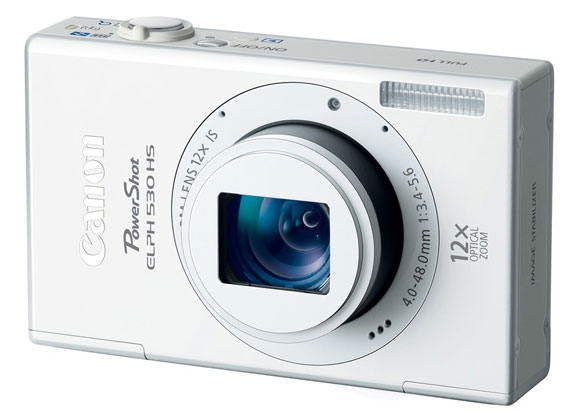Wednesday, February 8, 2012
Canon Announces Ten New Compacts
Posted by Lee Yuan Sheng in "Digital Home Hardware & Accessories" @ 10:00 AM

So the parade of compacts continues. Canon yesterday announced a bunch, and I will start with the more interesting ones. The Powershot ELPH 320 HS and ELPH 530 HS (IXUS 240 HS and IXUS 510 HS respectively outside of North America) are the latest additions to the ELPH/IXUS line up. The 320 HS features a 16 megapixel sensor with a 5x optically stabilised 24-120mm equivalent f/2.7-5.9 zoom lens, while the 530 HS features a 10 megapixel sensor with a 12x optically stabilised 28-336mm equivalent f/3.4-5.6 zoom lens. This uses folded optics to get fit into the small body. The two ELPHs share a lot of features otherwise, with a 3.2" HVGA touchscreen LCD and very little physical controls, 1080p video at 24 FPS, still shooting at up to 5.2 FPS, and new here, built-in wifi that in addition to uploading to various services, also allows transferring files to a smartphone, with an app coming for iOS and Android. The 530 HS also uses microSD cards instead of the usual SD cards for storing its photos. I sense many cameras will switch to the smaller form factor as time goes by; this is the third camera announced in 2012 utilising the smaller format. The two cameras will ship in late March, with the 530 HS going for US$350, and the 320 HS going for US$280. More cameras after the break!
DCResource: Powershot ELPH 320 HS / ELPH 530 HS
Next up, is travelzoom camera, the Powershot SX 260 HS. The SX 260 HS features a 12 megapixel sensor, a big 20x (up from 14x) optically stabilised 25-500mm equivalent f/3.5-6.8 (!) lens, a 3" HVGA LCD, 1080p video at 24 FPS, manual control of exposure, GPS and the usual Canon additions like high speed video and special effect modes. The SX 260 HS will ship in March for US$350. There also appears to be a SX 240 HS, which is the same as the SX 260 HS, but without the GPS, and does not look like it will be headed to North America.
DCResource: Powershot SX 260 HS
The Powershot D20 is an update to the D10, which has gone so long without an update I thought Canon had abandoned the rugged compact area. This is a more conventional affair, without the bulbous look the D10 had. Like the most rugged cameras, the D20's specifications are rather plain. It comes with a 12 megapixel sensor, a 5x optically stabilised 28-140mm equivalent f/3.9-4.8 zoom lens, a 3" HVGA LCD, 1080p video at 24 FPS, GPS, and of course, a rugged body that is waterproof to 33 feet (10 metres), shockproof from 5 feet (1.5 metres), freezeproof to 14F (-10C), and dustproof. The camera will ship in May for US$350.
Finally, Canon also announced six A-series budget compacts. I really am not sure what camera companies are doing. This is the segment most threatened by camera phones, has declining margins, and they see it fit to iterate more cameras at extremely fine price points. This is like fighting fire with fire, but being on the losing end.
Anyway, the six cameras share the same 16 megapixel CCD, and five use the same 5x 28-140mm equivalent f/2.8-6.9 (!) zoom lens. All are capable of recording 720p video at 25 FPS. The odd one out is the most expensive of the lot, the Powershot A4000 IS (US$200, ships in February), which uses an 8x optically stabilised 28-224mm equivalent f/3.0-5.9 zoom lens. It also uses a 3" QVGA LCD screen. The Powershot A3400 IS (US$180, ships in March) has a 3" QVGA touchscreen LCD, while the Powershot A2400 IS (US$160, ships in March) differs only from having a 2.7" QVGA screen. Both the A2400 and A2400 utilise the optically stabilised version of the 5x zoom lens. The Powershot A2300 (US$150, ships in March) is basically the A2400 IS without the IS, and the Powershot A1300 and A810 (US$120 and US110, ships in April) are the chunkier versions, utilising two AA batteries as a power source. The only difference between the two is the A1300 having an optical viewfinder.












